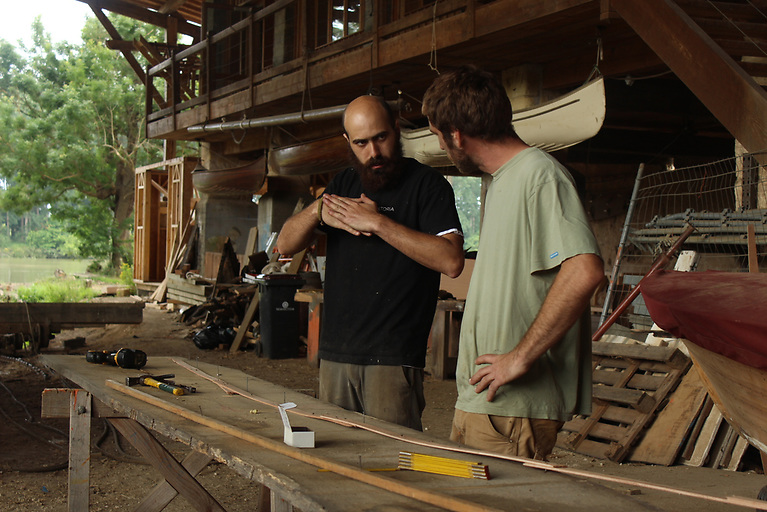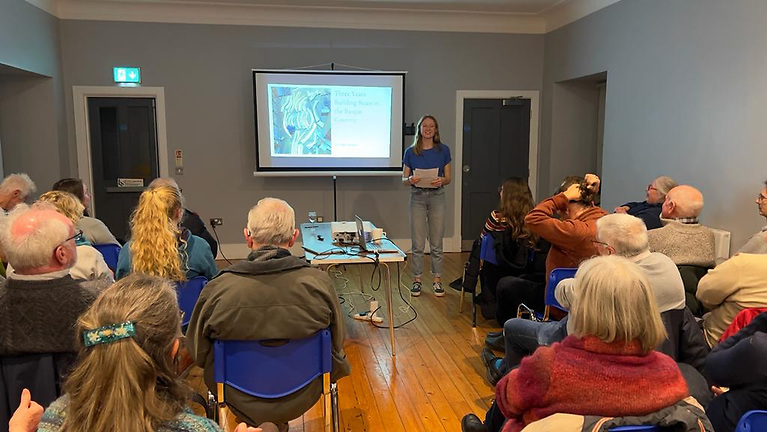Heritage Foyle Punt to be Built by Northern Ireland Student in Basque Boatyard
The following article was written by Betty Armstrong for Afloat.ie, to read the article on their website please click the following LINK
The Portaferry and Strangford Trust (PAST) is a charity, based in Portaferry at the mouth of Strangford Lough in Northern Ireland, which aims to promote an awareness of the rich maritime heritage and natural environment of the Lough and the sea in general.
The Trust recently hosted a talk by Orlagh Thompson titled ‘Three years building boats in the Basque country. Orlagh was an enthusiastic speaker. She is in her third and final year learning traditional boatbuilding at Albaola, the Basque Maritime Heritage Association in Pasaia in the Basque Autonomous Community of northern Spain. It is a fishing community and commercial port.
Currachs
Orlagh rowed currachs with the Causeway Coast Maritime Heritage Group on the North Coast. In 2003, she took part in a circumnavigation of Ireland in the 12-metre currach, Colmcille, which was accompanied by the traditional Basque fishing vessel Amerikataktik. A past student of languages at University College Cork, she has been involved in other rowing voyages.
Albaola
Orlagh started at Albaola in 2021. It consists of a maritime museum, a traditional boatbuilding school and a project to build a replica of the 16th-century whaling ship, the San Juan. Its boatbuilding philosophy is based on ‘thought and action’ and requires self-motivation. The course is free, lasts three years and is based on a 5-day week. The students are from a variety of countries, and many friendships are made. The week begins on Tuesdays with a walkaround to receive an update on all the projects.
Patatxe
Orlagh has been involved in a number of builds with the first being an Ala – a flat-bottomed river boat. She helped build the mast and oars for a Patatxe, an 18th century, 15-metre-long boat with 20 rowers. She described the process of lofting – the conversion of a lines plan to a full size one so that full-size components can be cut. Her task was to cut the rabbets at the stem posts, and the hull is a mixture of clinker and carvel construction. The wood is bought by the Albaola shipyard from local forests.
Txalupas
After this, she moved on to Txalupas – these are eight metres in length, were carried in whaling ships and used to catch whales. The plan is to make five of them to be carried aboard the replica San Juan, a three-masted, 27-metre, 300-ton vessel that sank in Red Bay in Labrador, Canada in 1565 in fairly shallow water. It took archaeologists thirty years to excavate and study the wreck. The parts were restored to their resting place when the process was complete. The beech keel for the replica was laid in 2014 and the remainder of the vessel will use 200 oak trees.
Foyle Punt
The Foyle Punt is a familiar sight on Lough Foyle in the northwest of Northern Ireland. The boats built at Albaola are usually from the Basque region but Orlagh has persuaded them to allow her to build this Irish boat in her remaining time there. To research the Foyle Punt, she visited to McDonald’s boatyard in Greencastle Co. Donegal. They have built Foyle Punts and Drontheims, the latter being replicas of Norwegian yawls carried as deck cargo on ships importing timber to the North coast of Ireland in the mid-18th century. They were copied and built as fishing craft in Co Donegal. Orlagh also visited the Inishowen Maritime Museum. Her dream is to then build a Drontheim for which she has line plans drawn by Harry Madill.
James Elliot from the Trust was delighted with the interest in Orlagh’s talk. “I think it may have been the best attended we’ve ever had. Orlagh was enthusiastic and really grabbed everyone’s attention and imagination. We look forward to hearing about progress with the Foyle punt”.




